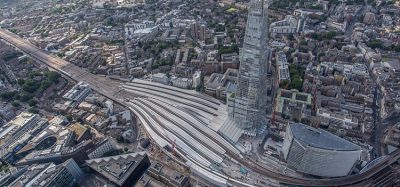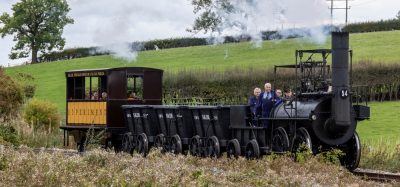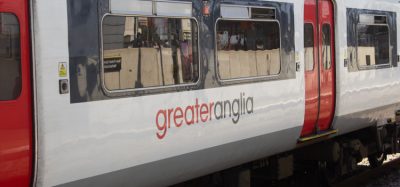Translink leads the way in sustainable station development
Posted: 4 December 2013 | | No comments yet
In 2012/13, Translink rail passenger journeys reached a record breaking 11.5 million – an increase of 7% on the previous year. Overall, there were 78.5 million Translink passenger journeys on bus and train last year beating the Northern Ireland government’s target of 77 million.
During the summer of 2013, Translink success – fully completed two major infrastructure projects transforming passenger facilities in two busy towns in the North East and South of the country. The construction of Antrim Bus and Rail Centre brought Northern Ireland its first sustainable low carbon station and the redevelopment of Portadown Train Station provided an important gateway into an area which had seen annual rail passenger throughput increase by around 19% in the last five years.
Both projects were funded by Northern Ireland’s Department for Regional Development and the European Union’s INTERREG IVA (Portadown) and IVB (Antrim) Programmes.
In 2012/13, Translink rail passenger journeys reached a record breaking 11.5 million – an increase of 7% on the previous year. Overall, there were 78.5 million Translink passenger journeys on bus and train last year beating the Northern Ireland government’s target of 77 million. During the summer of 2013, Translink success - fully completed two major infrastructure projects transforming passenger facilities in two busy towns in the North East and South of the country. The construction of Antrim Bus and Rail Centre brought Northern Ireland its first sustainable low carbon station and the redevelopment of Portadown Train Station provided an important gateway into an area which had seen annual rail passenger throughput increase by around 19% in the last five years. Both projects were funded by Northern Ireland’s Department for Regional Development and the European Union’s INTERREG IVA (Portadown) and IVB (Antrim) Programmes.
In 2012/13, Translink rail passenger journeys reached a record breaking 11.5 million – an increase of 7% on the previous year. Overall, there were 78.5 million Translink passenger journeys on bus and train last year beating the Northern Ireland government’s target of 77 million.
During the summer of 2013, Translink success – fully completed two major infrastructure projects transforming passenger facilities in two busy towns in the North East and South of the country. The construction of Antrim Bus and Rail Centre brought Northern Ireland its first sustainable low carbon station and the redevelopment of Portadown Train Station provided an important gateway into an area which had seen annual rail passenger throughput increase by around 19% in the last five years.
Both projects were funded by Northern Ireland’s Department for Regional Development and the European Union’s INTERREG IVA (Portadown) and IVB (Antrim) Programmes.
Antrim Bus and Rail Centre
Construction work on Antrim’s new £2.9 million bus and rail centre began in early 2012. It forms part of the European Union’s innovative ‘SusStation: Achieving Sustainable Stations’ project which supports the construction of sustainable, low carbon stations.
SusStation involves five partner organisations from transport authorities across Germany, the Netherlands, France and the UK. It is committed to: delivering more sustainable construction and management of station buildings; lowering carbon emissions from the rail sector; creating a rail industry environment that encourages sustainable station development; creating new marketing opportunities; and working with the rail industry, government and the public to change attitudes towards sustainable transport.
The Antrim Bus and Rail Centre is an example of European sustainable station development ‘best practice’. An effective mix of old and new, the project restored the original 1902 station’s Grade 2B architecture and façade, incorporating it with the latest environmentally sound technologies and major eco-refurbishments.
The facility reflects Translink’s companywide focus on managing and minimising its environmental impact. Innovative ecotechnology and biodiversity initiatives were combined with excellent passenger comfort and accessibility features to create a first-class passenger facility.
Before construction began, Translink customers in Antrim had to use two separate facilities for bus and rail services. The railway station at Antrim was a single-storey red brick building with an interior concourse leading to the main railway station platforms. It was a good example of a traditional early 20th century station house.
The separate Ulsterbus facility consisted of four departure stands with no dedicated bus forecourt or bus layover spaces; buses parked on an ad hoc basis around an engineering workshop. There was also no dedicated pedestrian entrance and exit and no enclosed facilities to service bus passengers.
New features
Key features and benefits of the new facility include: improved integrated bus and rail transport provision; park and ride extension to cater for 180 cars; an integrated ticket and information office; an enclosed accessible passenger waiting area; a canopy construction to cover most of the platforms; an electronic passenger information system; fully accessible toilet facilities plus a parent and baby room; new traffic management and improved pedestrian access; a CCTV system; covered bicycle parking; vending machines; passenger lift; and bus park extension.
Important sustainable features include: reclaimed clay facing bricks; roof-mounted solar panels; grey water harvesting system; natural ventilation; naturally insulated ‘green’ roof; geothermal heating system; and Swift Bricks to accommodate bird nesting at the site.
Translink’s on-going approach to sustainable business has received high profile industry recognition including The Carbon Trust Standard, top ‘Platinum’ status in the ARENA Network Environmental Benchmarking Survey and a Number 1 Northern Ireland ranking in the Carbon Reduction Commitment Energy Efficiency Scheme.
A range of business-wide actions have contributed to these results such as installation of energy efficient lighting, converting heating systems to run on gas instead of oil and installation of voluntary half-hourly electricity metering. These have delivered business benefits including: year-on-year reduction in energy costs; cutting carbon emissions; and enhancing the company’s public image.
Portadown Train Station
The £3.6 million Portadown Train Station Redevelopment Project commenced in February 2012. The major refurbishment and extension work saw the existing station building stripped back to its base structure and completely refinished inside and out to deliver a visually striking regeneration to meet customer needs now and in the future.
The new facility also complements Portadown’s recent public realm works which have transformed the town centre with a contemporary feel helping to rejuvenate the area and boost civic pride.
The station is just a five minute walk from the town centre and combined with modern trains operating along the Portadown railway line, it provides a considerable enhancement in service quality.
During the last five years, Portadown Train Station’s annual passenger throughput grew to over 930,000 – an increase of approximately 19%. In addition, there were around 3.5 million passenger journeys made on the Portadown railway line in 2012/13.
Translink maintained its customer-centric vision for this facility so that accessibility, passenger comfort, convenience and safety remained of paramount importance throughout all aspects of the redevelopment.
The quality of materials – both inside and out – was carefully chosen to create a bright and colourful environment. Passengers can also enjoy enhanced comfort with an enlarged waiting area.
A dedicated car turning head and passenger drop-off areas combined with increased disabled parking has enhanced park and ride convenience. A new bus stop and canopy also reflects Translink’s on-going integration between bus and train operations.
With sustainability in mind, improved integration of cycle facilities for employees and passengers were provided and the environment around the station is enhanced through attractive planting and landscape.
New features
In addition, enhanced station facilities include: replacement of the old underpass with a new ‘Disability Discrimination Act’ (DDA) compliant overhead track-crossing incorporating pass – enger lifts accessing island platforms; new DDA compliant lifts and stairs installed at the main entrance; a new passenger concourse benefiting from natural lighting and high quality tiled finishes; a crisp contemporary elevation to the station’s Northway due to new cladding and glazing installation; a series of energy efficient lighting systems; a new passenger canopy at the main entrance creating a visible landmark in the town; external PA system; electronic passenger information screens; and a CCTV system.
Enhanced station technical design features include: a fully-glazed wall to the train platforms enabling passengers to clearly see trains coming and going from the comfort of the passenger waiting area; an improved interface between employees and customers; new comprehensive lighting scheme resulting in a safe and welcoming facility all year round; a focus on sustainability – the original fabric of the station has been largely retained and upgraded to reach the recognised BREEAM Environmental Rating; improved general access to all external areas of the building including cycle facilities, passenger drop-off, taxi facilities and parking; and provision of a new cantilevered signal gantry improving train driver sight-lines, ensuring safety levels are maintained.
Community engagement
The successful delivery of both Antrim and Portadown projects also required the support of the local communities. In tandem with construction work, Translink delivered a community engagement programme to keep local people fully informed on construction work progress. A selection of engagement methods were used including on-site ‘hard hat’ tours for local politicians, customer information sessions and regular media features. In particular, the Antrim project adopted a variety of creative measures to boost levels of anticipation about the new facility and a sense of community ownership.
At the start of the project, Translink teamedup with its contractors to deliver a school art competition that asked children to design artwork which was then enlarged and used to decorate construction site hoardings. Competition themes were determined in line with Translink’s corporate responsibility objectives helping young people understand the importance of embracing more sustainable transport. Towards the end of the project, Translink also invited the public to submit items for an Antrim Bus and Rail Centre Time Capsule. The capsule was then installed at the station’s main entrance and will remain on display until its scheduled re-opening in 50 years’ time.
Looking ahead
Translink welcomed an additional 1.5 million fare paying passengers on-board bus and rail services in 2012/13 compared to the previous year. To continue this success, Translink remains committed to its vision of providing integrated travel solutions that are attractive, sustainable and good value. The Antrim and Portadown construction projects have now delivered two new innovative local transport hubs that will play a huge role in supporting passenger growth and contributing to economic, social and environmental development in Northern Ireland. They also provide ‘best practice’ examples for future station construction projects.
Biography
Clive Bradberry is Infrastructure Executive at Translink. He has 27 years of experience in the delivery of public transport ranging from heavy rail, metro and light-rail projects to tendered bus services. Clive joined London Underground as a graduate civil engineer in 1986 and was involved in the design and construction of major works. In 1996 Clive transferred to Transport for London and became Project Manager for the £200 million Croydon Tramlink PFI scheme. Once Tramlink was operational, Clive moved to London Buses Limited to gain operational experience as the Performance Delivery Manager for all bus services in south London. Upon moving to Northern Ireland in 2001, Clive spent the first 18 months commuting back to GB to work for Network Rail on a variety of projects. Finally in 2003, Clive became the Infrastructure Executive for Translink heading a Division of approximately 200 staff with responsibilities for all stations, depots, garages, track, signalling and structures used to deliver bus and rail public transport services in Northern Ireland.
OUT NOW: The Definitive Guide to Rail’s Digital Future
The rail industry is undergoing a digital revolution, and you need to be ready. We have released our latest market report, “Track Insight: Digitalisation.”
This is not just another report; it’s your comprehensive guide to understanding and leveraging the profound technological shifts reshaping our industry. We move beyond the buzzwords to show you the tangible realities of AI, IoT, and advanced data analytics in rail.
Discover how to:
- Optimise operations and maintenance with real-time insights.
- Enhance passenger services through seamless, high-speed connectivity.
- Leverage technologies like LEO satellites to improve safety and efficiency.
Featuring expert analysis from leaders at Nomad Digital, Lucchini RS, Bentley Systems and more, this is a must-read for any rail professional.







